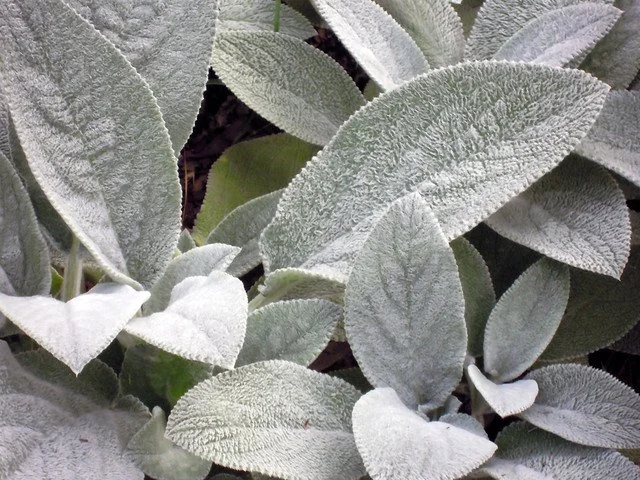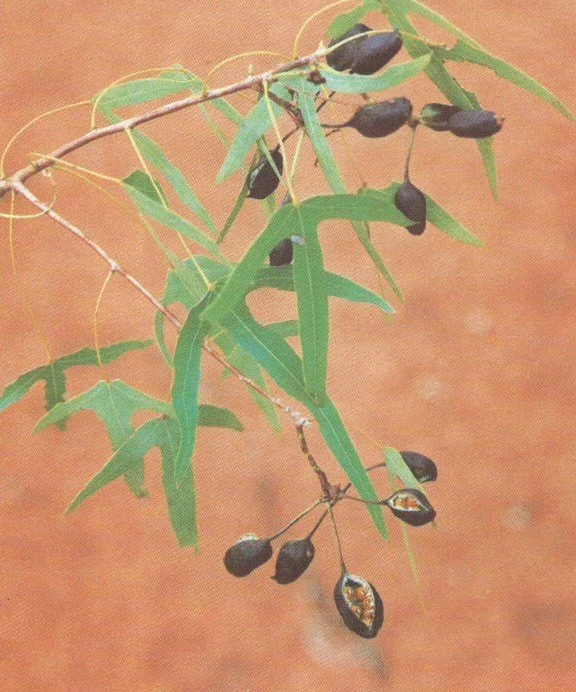On Country
How Plants Adapt
Show PowerPoint – All about leaves (TOOLBOX)
Flowering plants have been evolving for about 150 million years; time enough to adapt to the many different environmental conditions on Earth during that time.
Morphological adaptations in a plant
• Stems instead of leaves:
• Wattles have adapted to dry regions by a dramatic reduction in leaf surface. In Acacia rigens, leaves are needle-like, thereby reducing water loss and contact with heat radiation.
• In many species, such as A. saligna, leaves are dramatically reduced. Instead, the flattened and widened leaf stems (called phyllodes) develop and function as ‘leaves.’ Stems have thickened cell walls and contain few stomata compared with a leaf. Thus, transpiration is reduced, and water is conserved.
• The witchetty bush (A. kempeana), is well-adapted to hot conditions. The surface of the phyllodes is leathery, thickened with cellulose, which reduces evaporation. In addition, the phyllodes are often held in a drooping position, which reduces the direct infra-red rays from the Sun.
• Sheoaks (Allocasuarina spp.) have a similar reduction of their leaves. The ‘leaves’ are actually leaf stems, bundled together. The true leaves are reduced to a tiny whorl around the beginning of each bundle of stems.
• Leaf texture:
• Leathery leaves, greyish green in colour, particularly quandong trees (Santalam acuminatum, have the outer layer thickened with cellulose.
• They may also have oil glands, such as Eucalyptus spp. An oily surface retains moisture.
• Thick leaves denote water storage in cell vacuoles of both leaf and leaf stem. (eg. cactus, Carpobrotus (kolbogo)
• Leaf colour:
• ‘Grey’ leaves have a surface of very tiny white ‘hair-like’ protuberances from the outer layer of the cell wall that act to reflect the Sun’s heat radiation.
• ‘Hairs’ on leaves (and some flowers) divert the passing of dry air over the surface, reducing evaporation (eg. hairy petals of Mulla mulla, of leaf and fruit of bush tomato, Solanum sp.)
• In addition, they create a microclimate of humidity trapped at the leaf surface.
• Leaf surface:
• Sclerophylly (or hard leaves) is the term used to describe leaves that are tough and rigid and usually have a very thick outside surface (cuticle).
• Leaf shape or no leaves at all!
• A broad leaf can be divided into sections, as in the Desert Kurrajong (Brachychiton gregorii). This formation breaks up the wide surface of a large leaf, effectively reducing the surface for transpiration.
• The Desert Kurrajong drops all its leaves in conditions of very high temperatures. As dry air passes over the leaves, transpiration may be greater than the tree’s ability to draw in water stored in the roots.
• Roots:
• The desert kurrajong (Brachychiton gregorii) and particularly those of mallee eucalypts, store water in enlarged vacuoles (spaces) in the root cells.
• This was well-known to Aboriginal people who dug up the roots, cut them open and ‘water flows freely from them.’(1)
Activity
Make a Leaf Catalogue:
1. Collect
• While On Country, each student collects leaves of various colour, texture, size, shape, and thickness, and stems (with or without bark). Make sure there is variety in the material gathered.
• Several leaves may be collected from the school garden for comparison
2. Classify
In the classroom, have students describe the shape (straight or curly), size (short, long, thin, flat), texture (soft, hardened, spiny) and the nature of the leaf’s surface (thickness, colour, presence or absence of hairs, oily).
3. Discuss how each characteristic (trait) adapts the leaf to survive in a particular habitat. These might include:
• region of low rainfall (aridity)
• area of extreme heat, such as northern and eastern Wheatbelt (aridity, high temperature)
• crowded with other plants and competing for sunlight (competition)
• growing in exposed and windy conditions (aridity)
• growing where they provide food for animals (insect predation)
4. Make the library
• Students draw and label each leaf, describing how it is adapted, and the selective force that has shaped it – lack of water (aridity), high temperatures, competition for sunlight, predation, etc.
• Collate each student’s contribution to provide a reference library for local plants.
Activity
Measure the Levels of Sclerophylly in Leaves:
In this activity, the hardness (sclerophylly) of the leaf is calculated from the weight of the leaf in comparison to a soft leaf.
MATERIALS
• Collect a bundle of hard leaves (bundle 1) from a eucalypt or banksia species
• Collect a bundle of soft leaves (bundle 2) from a garden or vegetable patch
• Balance
METHOD
1. Count the number of leaves in each bundle.
2. Measure the total area (i.e. length vs breadth) of a few leaves in each bundle, averaging the results.
3. Multiply the average area by the total number of leaves in each of the 2 bundles, (A1 and A2).
4. Weigh each bundle of leaves, (Mass1 and Mass2).
5. Calculate the level of sclerophylly in the leaves as the Mass divided by the total Area (g.cm^-2).
6. Write up, comparing the levels of sclerophylly in the 2 plant types as evidence of a morphological adaptation to heat in the species examined (banksia, hakea).
Chaenopodiaceae
Silvery Leaves
Mulla mulla an Nungarin
Desert Kurrajong leaves
Carpobrotus modesta
Hairy seed pods
Hakea platysperma
Banksia Leaves
Sheoak leaves, Allocasuarina campestris
Wattle Leaves









